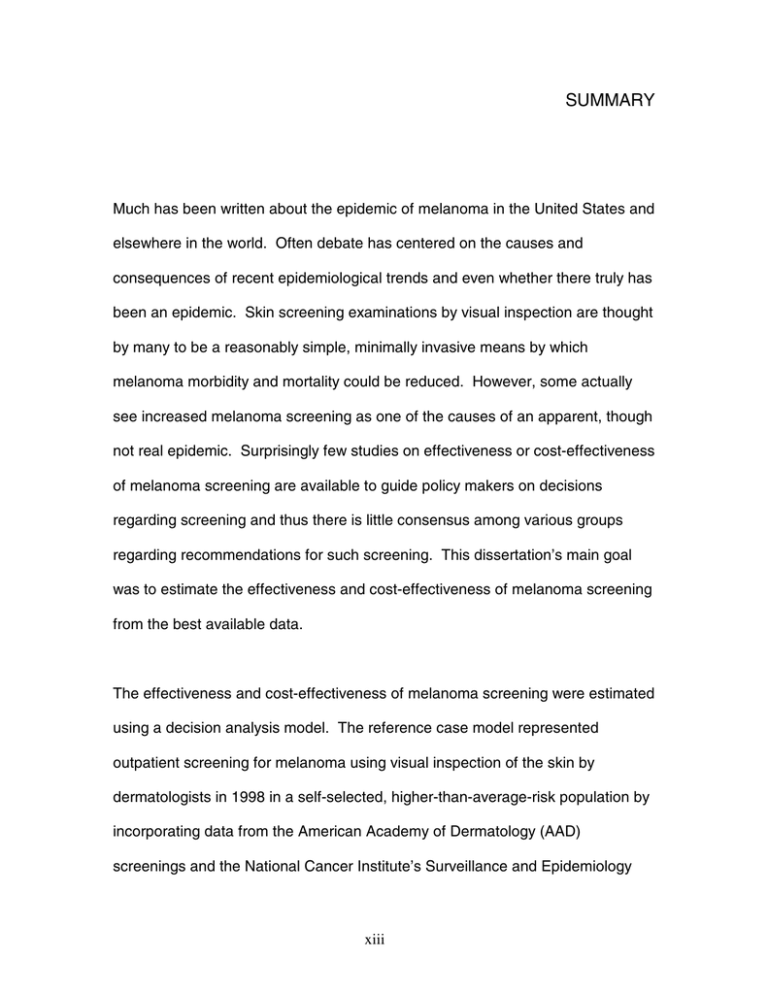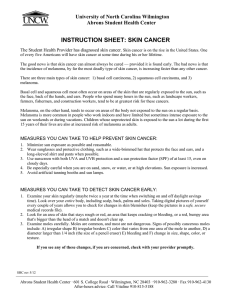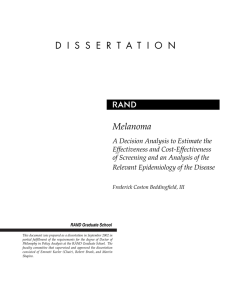SUMMARY
advertisement

SUMMARY Much has been written about the epidemic of melanoma in the United States and elsewhere in the world. Often debate has centered on the causes and consequences of recent epidemiological trends and even whether there truly has been an epidemic. Skin screening examinations by visual inspection are thought by many to be a reasonably simple, minimally invasive means by which melanoma morbidity and mortality could be reduced. However, some actually see increased melanoma screening as one of the causes of an apparent, though not real epidemic. Surprisingly few studies on effectiveness or cost-effectiveness of melanoma screening are available to guide policy makers on decisions regarding screening and thus there is little consensus among various groups regarding recommendations for such screening. This dissertation’s main goal was to estimate the effectiveness and cost-effectiveness of melanoma screening from the best available data. The effectiveness and cost-effectiveness of melanoma screening were estimated using a decision analysis model. The reference case model represented outpatient screening for melanoma using visual inspection of the skin by dermatologists in 1998 in a self-selected, higher-than-average-risk population by incorporating data from the American Academy of Dermatology (AAD) screenings and the National Cancer Institute’s Surveillance and Epidemiology xiii End Results (SEER) with estimates from the literature. The AAD screening results were compared to the SEER “usual care” from the societal perspective and the results were reported as cost per year-of-life-saved (YLS). Other hypothetical cases targeting populations by age and gender were analyzed. A sensitivity analysis was performed to examine the influence of varying key estimates on the cost-effectiveness. The results showed that one-time melanoma screening costs $51,481 per YLS. If the additional costs of evaluating and treating non-melanoma skin cancers as part of the melanoma screening were included in the analysis, the cost increased to $64,646 per YLS, but there would be additional non-life-saving benefits of early diagnosis and treatment of non-melanoma skin cancers. When future health costs were incorporated into the reference case analysis, the cost per YLS increased from $51,481 to $57,639. For a one-time screen of a self-selected population age fifty or above, the cost-effectiveness ratio was $18,904 per YLS for men and $30,888 per YLS for women. A one-time mass screening of the entire Caucasian population cost $172,276 per YLS. Patients with screendetected melanomas had an 87.8% ten-year survival versus an 83.6% ten-year survival for melanomas detected by the status quo. Screening resulted in an expected benefit of 7.76 lives not lost to melanoma over ten years and an additional eighty-seven life-years per 100,000 patients screened when compared to current care. The cost of providing the initial screen was a major determinant of the total cost of the program. The cost-effectiveness of many of these xiv melanoma screening scenarios fall within the range of other currently funded cancer screening programs. As part of the goal of estimating the effectiveness and cost-effectiveness of screening, age-and gender-specific melanoma incidence and survival rates were calculated from three databases including: 1) the Surveillance Epidemiology and End Results (SEER), 2) the California Cancer Registry, and 3) the University of California at Irvine Cancer Registries for San Diego, Imperial and Orange Counties. Melanoma incidence rates are strikingly different when stratified by age and gender and these findings, which have not been reported previously, were consistent in the analyses of all three databases. The incidence of melanoma increased with age for men and women, and more specifically the following patterns were noted. Prior to the age of forty, the incidence in men and women is very similar except that women have a slightly higher rate. After age forty the incidence continues to rise at a relatively constant rate until the end of life in men, but a plateau is noted in the incidence curve in women from approximately age 45 to 60, a time that correlates roughly with menopause. During this menopausal period in women, there is little rise in incidence. After age 60 there is a slight increase in incidence with age with women, but still the rate of increase with age is not as fast as it had been prior to menopause. This distinct pattern in women was analyzed relative to melanoma histological type and the pattern is due largely to the pattern seen in superficial spreading melanomas. In addition to these findings, the results showed that not only are xv men at higher risk of melanomas with age, they are also at higher risk of melanomas of advanced Breslow thickness. Women have a clearly higher rate of melanoma incidence than men only for thin lesions when under the age of forty. It is unclear whether these patterns are due to environmental, hormonal, or other possible causes. Nonetheless, the patterns are intriguing and have important implications for targeting primary and secondary melanoma prevention programs. The results of these analyses should be seen as an attempt to use the best available data to-date in order to estimate the effectiveness and costeffectiveness of melanoma screening and to understand factors impacting any such screening program implemented. The results described suggest that melanoma screening is likely effective and has a cost-effectiveness similar to many other cancer screening programs. Also, these findings make a strong case for a clinical trial of melanoma screening with prospective data collection given the likelihood of favorable findings. The results of these analyses could also be used to help design a study of melanoma screening, by helping to determine which groups to target in an initial study. The results suggest that using age and possibly gender would be an easy way of targeting a higher risk population with a lower study cost and a more favorable cost-effectiveness than if the general population were screened. Because the cost of the screen is a major determinant of the total costs of screening, ways in which the cost of the initial screen could be lowered should be explored as well. Ways of lowering the initial xvi screen costs include the use of non-dermatologists screeners such primary care physicians, specifically-trained nurses, nurse practitioners, or newer computerassisted screening devices incorporating digital photography. A logical and consistent approach to melanoma screening will only be achieved after the necessary foundation of research has been performed. While such research is still lacking, it is hoped that this dissertation contributes substantively to the current understanding of melanoma and melanoma screening. xvii



